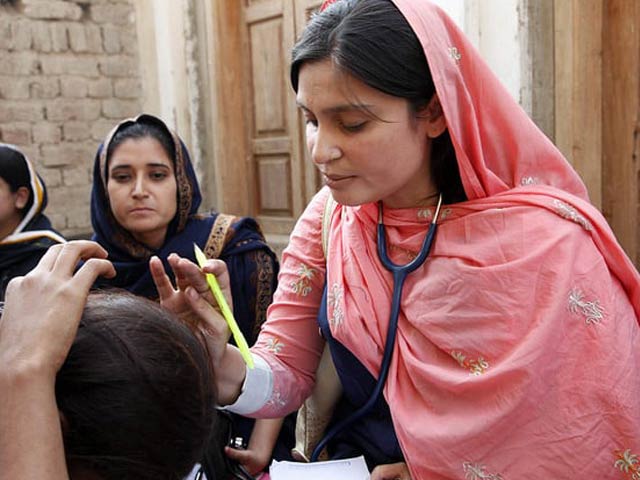In Pakistan, 35% of lady doctors are out of hospitals due to which billions of rupees are wasted annually. Photo: The Express Tribune
Karachi: Despite a shortage of medical professionals in Pakistan, the world’s fifth largest country by population, a large number of women doctors are not employed, even though the government in the resource-poor country subsidizes medical education in public sector universities to the tune of billions of rupees.
According to a joint report by Gallup Pakistan and Pride, 35% of female medical doctors are not employed in Pakistan. Based on their Laborforce 2020-21 research, Gallup Pakistan and PRIDE analyzed data from the Pakistan Bureau of Statistics on the labor market, specifically female medical graduates, and provided it to the country’s policy makers.
On the one hand, there is a severe shortage of qualified doctors in Pakistan, while on the other hand, more than 36,000 female doctors are either unemployed or opting out of the labor force for various reasons. Bilal Gilani, Executive Director of Gallup Pakistan, said in this context that there is a shortage of trained medical doctors in Pakistan and lack of qualified female doctors is a major problem. He said that the loss of precious taxpayers’ money due to the cost of non-performing doctors and the loss of health outcomes due to the absence of these doctors has to be considered. According to the results of the survey, there are currently 104,974 female medical graduates in Pakistan, of which 68,209 (65 percent) are providing medical services in various private and public institutions, while 15,619 (14.9 percent) female doctors are not working and 20.1 percent of the total number are 21146 percent women doctors are completely out of the labor force.
According to the Pakistan Medical and Dental Council, since its establishment in 1947, Pakistan has produced nearly 2 lakh doctors, half of whom are women. According to the data of the Bureau of Immigration, about 30 thousand doctors have left Pakistan since 1970 and on an average about 1 thousand doctors are going abroad every year. Most of these doctors studied in public universities where the government is spending billions of rupees to subsidize education.
Loss of billions of subsidies
An average private university charges medical students over Rs 50 lakh as fees while the government provides the same education for less than Rs 10 lakh. In this way, the government has to give a subsidy of at least 40 lakh rupees to make a medical doctor.
According to the results of the survey, this tax payer’s money is being wasted as one out of every 3 female doctors is not working after heavy government subsidies. According to current values, at least 200 billion rupees worth of investment on about 50,000 women doctors has been lost.
According to Dr. Shahid Naeem, director of policy research at PRIDE, one in five medical graduates chooses to stay out of the labor force, and out of the labor force, female medical graduates are more highly educated. Dr. Shahid Naeem said that the government should review the policy of allocating seats in public sector medical colleges to save valuable foreign exchange. He said that the exclusion of female medical graduates or doctors from the labor force after completing medical education is a serious problem and needs further research.
The survey also reveals differences in the employment of doctors on a regional basis. Out of the total graduates of Pakistan, 72% are urban and 28% of doctors are residing in rural areas. More than half of medical graduates in rural areas are employed and 31% are unemployed, while 17% of medical graduates in rural areas prefer to stay out of the labor force, less than the national average of 20%.
Dr. Bride
According to data from urban centers, about 70 percent of medical graduates are employed while less than 9 percent are unemployed, while the proportion of medical graduates who choose to stay out of the labor force in urban areas is over 21 percent. Similarly, when comparing urban and rural areas, there are 78% employment opportunities for female medical graduates in urban areas and only 22% in rural areas.
On the contrary, unemployment rate is higher in rural areas with 57% while unemployment rate in cities is 43%. Out of the 21,146 women medical graduates outside the labor force, the proportion of urban areas is 76.6% and rural areas are 23.4%.
It is noteworthy here that out of the 21146 female medical graduates outside the labor force, 76% are married, while the ratio of female medical graduates in the age group of 25 to 34 years is more than 54%.
Analysis of survey data highlights the importance of targeted policy efforts to improve employment opportunities for medical graduates, particularly in rural areas where unemployment rates are high.
The results of this survey support the phenomenon of ‘doctor brides’ as widely discussed and reported in Pakistan that many families prefer their daughters to study medicine because This facilitates them in a suitable relationship for marriage.
The survey included female medical graduates who have completed BDS, MBBS, MPhil MS or MSc or PhD in any field of medicine. The survey collected data from around 99,900 households across Pakistan and will also provide district-level results for the first time.
(function(d, s, id){
var js, fjs = d.getElementsByTagName(s)[0];
if (d.getElementById(id)) {return;}
js = d.createElement(s); js.id = id;
js.src = “//connect.facebook.net/en_US/sdk.js#xfbml=1&version=v2.3&appId=770767426360150”;
fjs.parentNode.insertBefore(js, fjs);
}(document, ‘script’, ‘facebook-jssdk’));
(function(d, s, id) {
var js, fjs = d.getElementsByTagName(s)[0];
if (d.getElementById(id)) return;
js = d.createElement(s); js.id = id;
js.src = “//connect.facebook.net/en_GB/sdk.js#xfbml=1&version=v2.7”;
fjs.parentNode.insertBefore(js, fjs);
}(document, ‘script’, ‘facebook-jssdk’));


